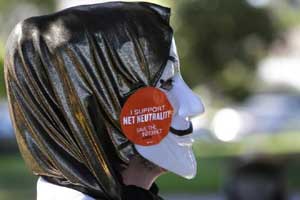Historically, the internet has worked as a transparent (neutral) pipe for exchange of information between any two points. The information can be used to support innovations, including ‘over the top’ (OTT) services which facilitate net-browsing (using sites like Google and Yahoo), social networking (Facebook and Twitter), video-sharing and streaming (Netflix and YouTube), voice-over internet protocol, or VoIP, (Skype and WhatsApp), e-commerce (Amazon, Snapdeal and Flipkart), and many more. To analyse the net neutrality issue, let us examine various stakeholders in rendering of net-based applications or services.
The major stakeholder in realising internet-based applications or services are (i) core or backbone providers, (ii) last-mile access providers, including internet and telecom service providers, (iii) content or application providers and finally, (iv) end devices, including smartphones and tablets. Among these, the core or backbone is facilitated by a consortium of global telecom companies and is shared by a very large number of users and content providers. Some times, the core makes use of traffic management tools, but given the magnitude and diversity of end-users, there is no scope for illegal traffic discrimination. The end devices, too, are ruled out from illegal traffic discrimination, as their role is to establish connection and utilise data.
Thus, responsibility for legal (or illegal) connection-discrimination lies only with the access provider. In the past, with circuit-switched mode of operations, the telecom service providers offering dial-up internet access neither had the capability nor interest in access discrimination. It is only after the advent of internet-based broadband access that the capability has become available with the telecom service providers. Even then, there was no initial problem, as data users only availed small fraction of access capacity and applications riding on the data, this did not pose any clash of interest with the access provider. It is only with the advent of OTT applications that access providers are feeling threatened or simply want their ‘pound of flesh’ given the lucrative business of OTT players. Their threat perception is reasonable, based on two counts: (i) huge increase in data traffic and poor incentive for capacity enhancement with relatively low data tariff and (ii) OTT application provider’s ability to offer similar or better voice and messaging services, free or at marginal rates as compared to standard tariff for conventional voice and messaging services. It is to be noted that zero or marginal fees being charged by the communication-OTT players is largely based on low rate of data access charges incurred by the users. The latter is based on standard business practice to subsidise new attention-gathering applications so long as their impact is small on core business. The communication-OTTs also gain from lax safety and licensing requirements. The subsidy argument for data access charges is evident from the closure of many pure-internet service providers in the country, who had no other sustainable business. Thus, we come to crux of the issue: Who pays for access capacity enhancement, especially in the case of mobile networks by way of spectrum, infrastructure and equipment costs?
The standard strategy is to use a combination of measures for differentiated billing, viz. ‘toll-boothing’ (for charging based on service category) or ‘zero-rating’ (service provider paying access charges). Another popular technique is to reserve and charge for ‘faster lanes’ carrying data-hungry applications like IP-TV, offered by some unified access providers or video-on-demand by Netflix-like operators. A range of discrimination options are available with traffic management tools like ‘deep packet inspection’ that is capable of marking, queuing and scheduling data packets in accordance with an operator-defined policy. Unfortunately, these measures oppose net neutrality in the absolute sense and the issue has been bitterly fought in many social, regulatory and legal gatherings around the world. Thus, it is only in February 2015, after a protracted legal battle and reclassification of ‘broadband access’ as ‘telecommunication service’, that the US FCC has taken a decision in favour of net neutrality—outlawing blocking of access and mandating transparent traffic management.
On the other hand, Europe has generally favoured market-driven approach so long as traffic management is handled in a transparent manner. The Body of European Regulators for Electronic Communication (BEREC) has also been constituted to monitor it. However, an extreme example of controlled internet is practised in China which has developed ‘inverse intranet’ (within the global internet) to limit access completely. Thus, there is no access to well known biggies, but equivalent local sites are available, viz. Baidu (for Google), Renren (Facebook), Sina Weibo (Twitter), Tudou or Youku (You Tube), Dangdang
(Amazon), Taobao.com (eBay), Meituan ( Groupon) and so on. In addition to meeting political goals, the ‘intranet’ has helped China in developing and building huge internet businesses. This includes Alibaba, one of the largest e–trading sites. The controlled internet policy has also allowed state-owned China Mobile to impose ‘termination charges’ for OTT communication services.
India, with its liberal thinking juxtaposed with its Make-in-India initiative, is at a critical juncture. Perhaps, we should not aim at ‘all or nothing’, but for a more suitable mix. One of the possible solutions is to reserve part of ‘access’ capacity (say 20%) for faster lanes of traffic (or zero-rating) against payment by the application company. The funds, so generated by the access providers (telecom service providers) can be used to fund free ‘access’ for another part of ‘access’ capacity (say 20%) for indigenous content and applications. The balance 60% ‘access’ capacity may thus be left free for ‘fair usage’ allocation with usage-based charging. The latter is recommended to avoid hogging of capacity by specialised applications. Either way, transparent traffic management needs to be mandated.
The author is former CTA, Sistema Shyam Teleservices Ltd (MTS), CTO, Reliance Infocomm, director (technical), Qualcomm; and counsellor (S&T), Embassy of India, Germany
For Updates Check Editorials and Columns; follow us on Facebook and Twitter
